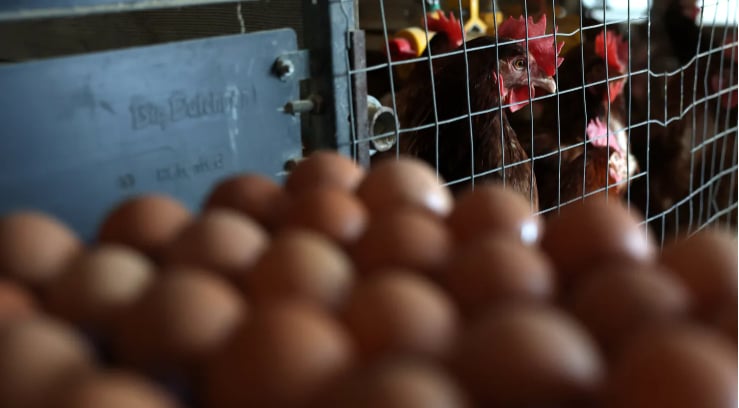November 14, 2025 | 10:33 GMT +7
November 14, 2025 | 10:33 GMT +7
Hotline: 0913.378.918
November 14, 2025 | 10:33 GMT +7
Hotline: 0913.378.918

Chickens stand next to stacks of eggs in a henhouse at Sunrise Farms on February 18, 2025 in Petaluma, California.
The cost of white large shell eggs declined to $6.85 per dozen, on average, last week, according to data from the U.S. Department of Agriculture. That represents a decline of $1.20 per dozen, and a 15% pull back the USDA’s prior update on Feb. 28.
“Demand for shell eggs continues to fade into the new month as no significant outbreaks of HPAI [highly pathogenic avian influenza] have been detected in nearly two weeks,” the USDA wrote in its March 7 weekly update. “This respite has provided an opportunity for production to make progress in reducing recent shell egg shortages.”
Egg prices have become a key pressure point for consumers that are tired of sticky inflation and worried about more potential price increases due to President Donald Trump’s tariffs on a wide array of imports. While it is still unknown the full ramifications of the duties on Canada, China and Mexico, stocks have so far pulled back in 2025 on concern the moves could further raise prices of goods and tip a sagging economy into a recession.
To be sure, the price of eggs have still skyrocketed more than 170% from a year ago, USDA data shows. The rise has spurred an investigation by the U.S. Department of Justice into allegations of anticompetitive practices from some of the largest egg producers in the country. Firms including Cal-Maine Foods have touted a crushing avian flu outbreak, which has forced the culling of millions of egg-laying hens, as the major catalyst for the rise in egg prices.
“The primary reason for the drop is actions taken by the administration’s Department of Justice to investigate the companies for possible antitrust violations,” said Joe Maxwell, president of Farm Action Fund, told CNBC. “The dominant firms have so much control over the market that they can increase prices and lower prices almost at will.”
“There has been a softening of demand for eggs by consumers, but we do not see this as a significant factor, considering this has been an ongoing trend,” Maxwell added.
Egg prices were a key factor in the February consumer price index report, with the Bureau of Labor Statistics noting prices advanced 10.4% last month and 58.8% year-over-year. The marked-up price tag for eggs has even pushed consumers to begin shifting their breakfast habits.
CNBC

(VAN) Malaysian durians are gaining worldwide recognition, from China to Europe and the U.S,, as exports have surged in recent years, driven by rising demand.

(VAN) Value chain linkages are becoming a key solution to enhance the competitiveness of Vietnamese agricultural products, improve climate resilience and strengthen their position in the global supply chain.

(VAN) From humble local delicacies, many businesses in the Mekong Delta have successfully conquered domestic and international markets with their distinctive One Commune One Product (OCOP) goods, contributing to sustainable rural economic development.

(VAN) The Vietnamese tilapia industry is only in the initial stages of export, yet its growth potential remains vast. To reach further, it needs to focus on breed stock, technology, and deep processing.
/2025/11/08/3402-1-212706_176.jpg)
(VAN) Viet Nam's fruit and vegetable exports continued to reach an extremely high turnover in October. With this growth momentum, the sector is expected to set a new milestone of USD 8.5 billion in 2025.
/2025/11/08/4950-1-163820_289.jpg)
(VAN) During the 2021–2025 period, Viet Nam's agro-forestry-fishery processing industry has made remarkable progress, achieving an average growth rate of 8%/year.

(VAN) Over 80 years, Vietnamese rice has journeyed through half a century to become a symbol of knowledge, resilience, and the new nation’s agriculture stature.